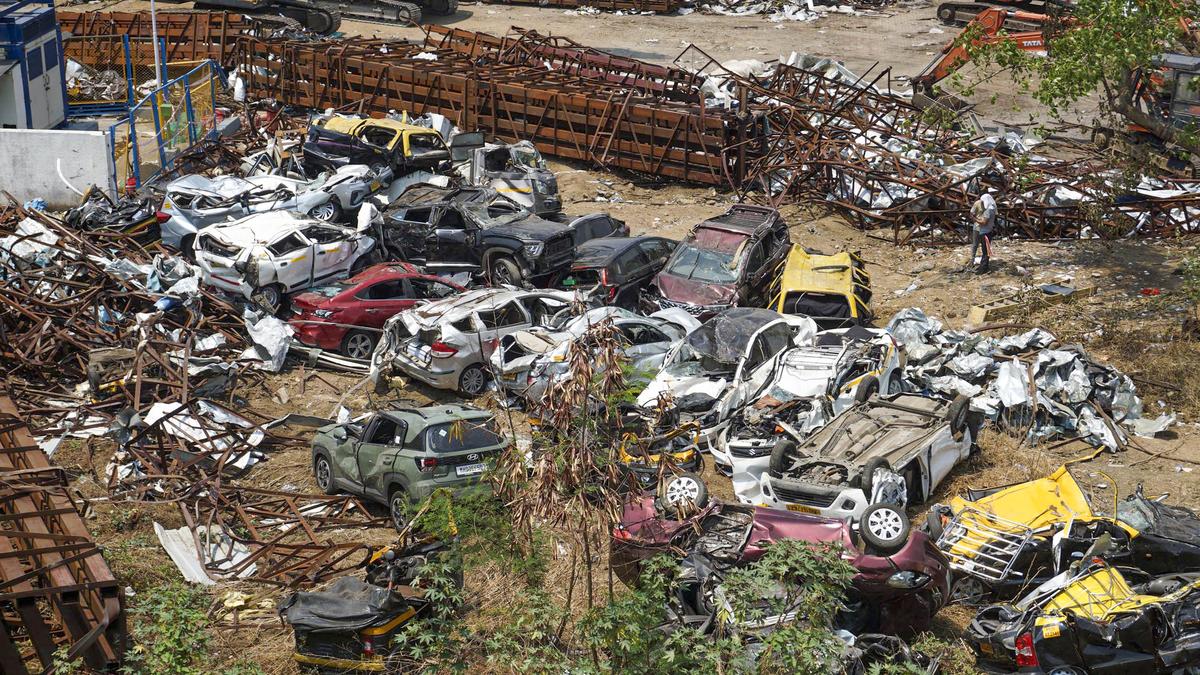
The takeaway from Mumbai hoarding tragedy Premium
The Hindu
Mumbai hoarding collapse kills 16, sparking nationwide scrutiny on hoarding safety and government liability in disasters.
The story so far: A giant advertisement hoarding in Mumbai’s Ghatkopar area collapsed in a dust storm in Mumbai on May 13, killing at least 16 people. The brunt of the monstrous 250-tonne structure’s fall was borne by a petrol pump below, where many of the victims were either fuelling up or going about their duties. The owner of the hoarding erected on massive metal frames in April, 2023 on Government Railway Police (GRP) land, Bhavesh Bhinde, absconded after the crash, but was later arrested in Rajasthan.
Pressure has built up on the Municipal Corporation of Greater Mumbai (BMC) to inspect and take action on illegal or unstable hoardings in the city, and to ask Railways and Mumbai Port Trust to provide stability certificates for others. Other cities too responded to the incident. Officials in Chennai, where a ban on hoardings is being lifted, removed over 460 structures. Several hundred applications to install hoardings are pending in the city. In Pune, a large hoarding fell on a parked truck soon after the Ghatkopar incident, but caused no injuries.
Local bodies issue licences for advertisement hoardings, particularly in bigger cities, stipulating that these structures should be approved by an executive authority. In Mumbai’s case, the Mumbai Municipal Corporation Act (MMC) dating back to 1888 and amended over time stipulates that written permission of the Municipal Commissioner is needed to put up such structures under Section 328A.
Advertisement hoardings must meet norms, and these were apparently liberalised for Greater Mumbai through the Policy Guidelines for Display of Advertisements 2018 to tap the city’s full financial potential. It is this document that makes structural stability certification from a registered structural engineer a condition for putting up hoardings, including sky signs that are larger than 100 sq. ft. For an on-ground hoarding on a site other than the business premises, the size limit is 40 feet by 40 feet as per this document. By all accounts, the massive hoarding in Ghatkopar did not meet size norms but was not brought down by official agencies in spite of being a highly visible hazardous structure. The Government Railway Police, on whose land the collapsed hoarding and others elsewhere have been put up, cited an ongoing dispute with the Corporation for not enforcing the law on hoardings, and took action only after the disaster. It is notable that the policy guidelines say hoardings existing as of May 1, 2014 should be reinstalled incorporating structural stability requirements, on a single pole or bipole, indicating that the Ghatkopar display would have had to meet safety norms.
From a technical perspective, the Bureau of Indian Standards (BIS) lays out specifications for wind loads on hoardings under IS875, Part 3, giving formulae on how to calculate the force coefficients applicable to these wind-facing structures. If such standards are indeed applied by municipal bodies around the country, the data is not made public. No database of permits could be located on the BMC website in the hoardings section.
State governments keen to raise revenues through outdoor advertisement hoardings have been adopting a more liberal attitude to big displays in public places, as urbanisation and consumption drive the economy. The advent of digital boards has brought with it the possibility of moving displays, opening up avenues for different advertisers to use the same screens to show messages, raising rents for hoardings companies greatly.
Several legacy-style hoardings built on heavy metal frames but lacking an adequately solid foundation coexist with the new displays, particularly along highways and wide urban roads. The MMC Act of 1888 provides some regulatory exemptions to hoardings on railway land. The Ghatkopar disaster demonstrates that extreme weather, such as high winds or a cyclone sweeping a city, quickly exposes the weakest infrastructure links, with deadly consequences. The focus now is also on how prepared municipal and disaster management authorities are to deal with the fallout in crowded cities. In the Mumbai incident, the presence of a petrol pump prevented personnel from using gas cutters to remove the twisted metal frame for fear of triggering a fire. Allowing hazardous structures to come up thus reduces the efficiency of disaster management expertise. Several local bodies lack the capability or administrative machinery to ensure structural stability of hoardings. Implicit in such incidents is the role of corruption.

NDA government in A.P. neglecting students and education sector badly hit, alleges Jagan Mohan Reddy
YSR Congress Party (YSRCP) president Y.S. Jagan Mohan Reddy has criticised the National Democratic Alliance (NDA) government in Andhra Pradesh, accusing it of neglecting all sectors and not paying the fee reimbursement benefits to the students.










